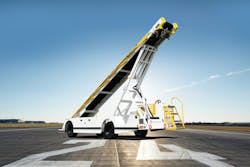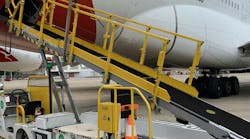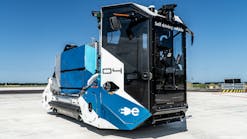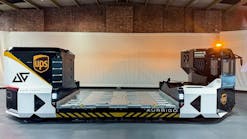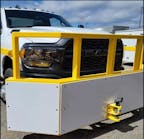Effective baggage handling is a fundamental element of the passenger journey in air travel. While passengers may only be concerned with their luggage arriving to their destination on time and undamaged, airlines and ground handlers must ensure baggage is handled correctly, while navigating numerous challenges in the busy airport ramp environment.
To help overcome baggage handling challenges and improve safety on the ramp, officials at Mallaghan gathered customer feedback and incorporated this information into the design of its recently launched SkyBelt.
“At the request of one of our global strategic partners, Mallaghan entered the aircraft belt loader market to bring our expertise and innovative ideas into the sector,” says Joe Griffith, chief commercial officer at Mallaghan.
In addition to incorporating electric tri-action drive control programming, lithium-ion battery technology and other operator safety features into its belt loader, Mallaghan engineers developed a patented lifting mechanism designed to improve operations and mitigate potential damage to the aircraft.
SkyBelt Development
The SkyBelt represents Mallaghan’s first fully electric standard belt loader, expanding the company’s line of belt loading equipment that also includes the extendable belt product, the Bendibelt.
Key features of the SkyBelt were designed to help overcome challenges associated with working in confined spaces, working within tight turnaround timelines and performing tasks in less-than-ideal ergonomic positions.
“Of primary importance was engaging with the customer and the operators to understand the challenges they faced and see what improvements they wanted to see over their existing equipment,” Griffith says. “This engagement was important throughout the whole design phase and right through to the prototype testing.”
As a result, Mallaghan produced a patented lifting mechanism and sensors aimed at reducing the risk of accidental damage to aircraft – the greatest risk seen when ground support equipment (GSE) approaches the aircraft.
Utilizing the company’s experience and expertise with scissor lifts, Mallaghan’s conveyor lifting system allows for vertical boom movement without any lateral/traversing movement. This helps eliminate the risk of fuselage contact and aircraft damage caused by lateral boom movement.
“Our patented lifting mechanism allows for the rear of the boom to be raised without causing horizontal movement at the front and risk of the boom making contact with the fuselage,” Griffith points out, adding operational procedures are also improved with this feature. “This was a key requirement for our customers as they see the lateral movement on other belt loaders as being a significant flaw in their design.
“They are overjoyed at this feature of the SkyBelt.”
The SkyBelt’s conveyor system is complemented by Mallaghan’s collision avoidance system (CAS) and auto-level functionality.
The auto-level system utilizes precision sensor technology, according to Griffith.
“Utilizing our experience from being at the forefront of CAS development, since its inception under AHM 913 in 2017, and coupled with the latest 3D radar technology available, we created a system that is unparalleled in performance and reliability,” Griffith adds. “The collision avoidance system uses the most advanced sensor technology that has only just become available.”
Additional SkyBelt options include multiple handrail options; EU package/CE certification; a wheel straight indicator; cargo door steps on the front of driver’s cab; rear conveyer hoop guard; wheel chocks; beacons; a work light; nylon side bump rails; and a fire extinguisher.
The European version of the product includes updates such as a fixed handrail on the boom, a higher protective guard on the inside of the driver cab and an inclinometer, among other features.
Many of the SkyBelt’s features offer safety benefits as well.
The CAS, for example, utilizes advanced sensor technology to passively operate in the background without requiring director operator involvement, Griffith explains.
“The system allows the operator to maintain focus on the basic driving functions,” he adds. “As well as providing peace of mind that the belt loader will prevent itself from damaging an aircraft due to operator error, the system also lessens the risk of accidents caused by driver distractions.”
Because the aircraft may change height during ramp operations due to the weight of cargo being loaded and passengers entering the cabin, the auto-level system provides automated boom movement tracking to the cargo floor level
“With ‘bag in bin’ operation, this is critical,” Griffith says. “And, as well as preventing aircraft contact, it has the added benefit of helping avoid operator entrapment between the boom and cargo floor.”
Other SkyBelt features include a modular chassis design and an AC traction motor with integrated electric park brake coupled to rear axle differential.
Key Collaboration
According to Griffith, Mallaghan officials are continuously involved in research and design projects, which helped in the development of the SkyBelt.
“The one thing that was beneficial on this project, more so than others, was how closely we worked with our customer,” Griffith says.
“Mallaghan came to the table with solutions to long-standing problems and delivered on every single aspect of the design,” says Alex Blench, general manager of GSE Central Services at Delta Air Lines. “What the team put together is certainly class-leading – it’s a game changer.”
Every feature incorporated into the SkyBelt’s design is intended to avoid aircraft impacts and associated issues – including costly aircraft repairs and flight delays.
“The features also make the operators’ job easier and more efficient,” Griffth says.
In addition to working with airline and ground handling partners, Mallaghan also worked side by side with others in the GSE industry to enhance the SkyBelt.
For example, the SkyBelt utilizes Flux Power lithium-ion 80-volt batteries, provided by Averest.
“Partnering with Averest, with their expertise and experience, gave us peace of mind and confidence that the battery side of the project wouldn’t be an issue and let us focus on all other aspects,” Griffith says.
Sensor technology and telematics data is powered by Adveez, in addition to the on-board diagnostics screen.
“During the testing phase, the Adveez technology proved to be very beneficial in recording operational data and proving performance,” Griffith says.
Production of the SkyBelt began in mid-2023, and more than 150 units were produced in the first 12 months.
The SkyBelt is currently in operation at Seattle-Tacoma International Airport (SEA), Los Angeles International Airport (LAX), New York’s John F. Kennedy International Airport (JFK) and LaGuardia Airport (LGA), and Hartsfield-Jackson Atlanta International Airport (ATL).
According to Griffith, the SkyBelt delivers several key benefits to customers in addition to reducing aircraft damage incidents, such as reducing maintenance costs and enhancing sustainability credentials at a time when the industry is putting a collective focus on environmentally responsible operations.
